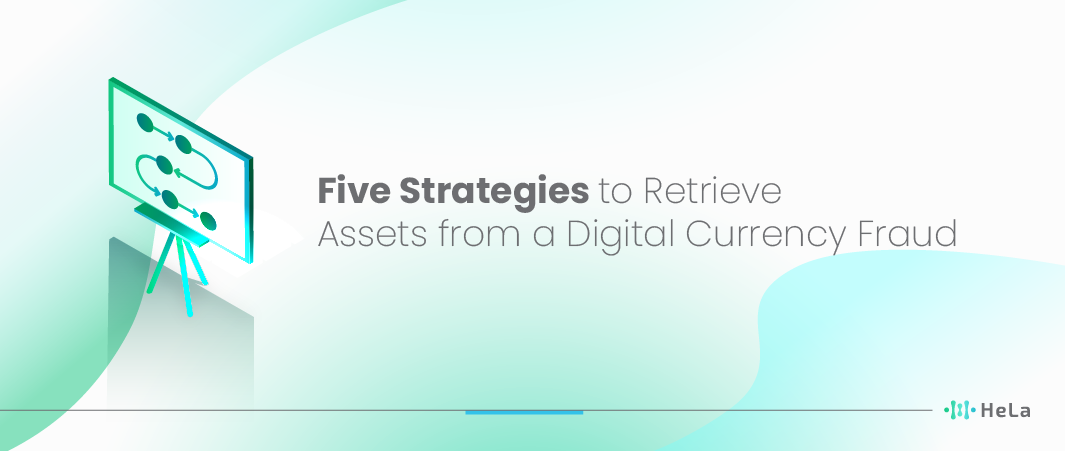In the fast-paced world of digital currency, the rise of cryptocurrency scams has unfortunately become a prevalent issue. Victims of these scams often feel helpless and unsure of how to recover their lost funds. However, hope is not lost. This article provides a comprehensive guide outlining five practical ways to recover assets lost to cryptocurrency scams. It aims to empower individuals with the knowledge and resources necessary to navigate the recovery process effectively.
Understanding the nature of cryptocurrency scams is the first step in combating them. These scams can take many forms, including phishing attacks, fake ICOs (Initial Coin Offerings), and Ponzi schemes, among others. Regardless of the method, the result is the same: unsuspecting investors are deceived into sending their funds to scammers. Recognizing the common red flags associated with these scams is crucial for prevention and recovery.
The emotional and financial toll of falling victim to a cryptocurrency scam can be overwhelming. However, it’s important to act swiftly and calmly to increase the chances of recovering your funds. The following sections will discuss various strategies, legal avenues, and precautionary measures you can take. From contacting authorities to leveraging blockchain analysis, these methods provide a beacon of hope for victims seeking to reclaim their assets.
Understanding and Avoiding Cryptocurrency Scams

In an ever-evolving digital landscape, the realm of cryptocurrencies has not been immune to scams and fraudulent activities. This section aims to empower readers with the knowledge and tools necessary to protect themselves from falling victim to cryptocurrency scams.
Types of Cryptocurrency Scams
Cryptocurrency scams come in various forms, ranging from classic Ponzi schemes and pump-and-dump schemes to more sophisticated phishing attacks and fake ICOs (Initial Coin Offerings). By delving into the different types of scams, readers will gain a comprehensive understanding of the tactics employed by scammers to exploit unsuspecting investors.
Recognizing the Red Flags
Recognizing cryptocurrency scams requires a keen eye for red flags. These indicators may include unrealistic promises of high returns, pressure tactics to invest quickly, vague or overly complex technical jargon, and promises of guaranteed profits. By equipping readers with the ability to identify these warning signs, they can better protect their investments and financial well-being.
Also Read: Top List of Crypto Airdrop to Check in January 2024
The Importance of Due Diligence
Due diligence is a critical aspect of safeguarding your cryptocurrency investments. This section underscores the significance of thoroughly researching any cryptocurrency project before committing funds. Readers will learn about the importance of verifying the project’s team members, checking for a clear roadmap, and understanding the underlying technology. By conducting proper due diligence, investors can filter out potential scams from legitimate opportunities.
Staying Informed and Community Vigilance
Remaining up-to-date with the latest news and developments in the cryptocurrency community is paramount. Readers will discover the value of staying informed about known scams, hacks, and fraudulent projects. By participating in cryptocurrency forums, following reputable news sources, and engaging with the community, individuals can tap into collective knowledge and steer clear of potential pitfalls.
5 Ways To Recover Funds From Cryptocurrency Scam
Recovering funds from a cryptocurrency scam can be a challenging and complex process, but it’s essential to take action as soon as you realize you’ve been a victim. Cryptocurrency scams can take various forms, including Ponzi schemes, fake ICOs (Initial Coin Offerings), phishing attacks, and fraudulent investment platforms. Here are five ways to recover funds from a cryptocurrency scam:
1. Contact Law Enforcement
Engaging with local law enforcement or the appropriate legal authorities is a fundamental and proactive step in addressing the scam. It involves providing them with exhaustive and detailed evidence of the fraudulent activity, such as transaction logs, communications, and any additional pertinent information that might aid in the investigation.
Law enforcement units have the specialized tools, international contacts, and legal authority to conduct in-depth investigations, and in certain circumstances, they can initiate criminal proceedings against the scammers. This not only aids in your individual case but also contributes to the broader fight against cybercrime and cryptocurrency scams, potentially safeguarding future potential victims.
2. Seek Legal Advice
Legal complexities in cryptocurrency scams require the expertise of attorneys specializing in financial fraud and cyber law. These legal professionals can demystify the often complex legal landscape, offering clarity on your rights and the potential for recourse.
They guide you through the intricate process of legal action, whether it’s initiating a personal lawsuit or joining a broader class-action lawsuit against the fraudsters. Their expertise is invaluable in navigating the justice system, formulating strategies for asset recovery, and offering a chance to hold the perpetrators accountable under the law.
3. Contact the Exchange or Platform
Immediate communication with the cryptocurrency exchange or trading platform is vital in the wake of a scam. By promptly alerting them and providing a detailed account of the fraudulent transaction, including specific wallet addresses and transaction IDs, you enable these platforms to take swift action.
This may include freezing accounts, tracking the illicit flow of funds, and potentially working with law enforcement to trace and recover assets. Additionally, these platforms often have policies and measures in place to protect users against fraud, and your report can trigger these protective mechanisms.
4. Use Blockchain Analysis Tools
Leveraging blockchain analysis tools or consulting with firms that specialize in such investigations can provide a technical edge in tracing stolen assets. These tools scrutinize the blockchain, tracking the flow of your stolen funds, identifying the recipient wallets, and often uncovering the web of transactions designed to obfuscate the trail.
This level of analysis is crucial, providing substantive data that can be used in legal cases, aiding law enforcement in their investigations, and even helping to paint a broader picture of scam operations for future preventive measures. While recovery of assets is not guaranteed, the intelligence gathered is invaluable.
5. Raise Awareness and Share Information
Finally, becoming an advocate for awareness in the cryptocurrency community is a powerful way to combat scams. By sharing your ordeal, you alert others to the methods and profiles of scammers, contributing to a collective defense mechanism.
Encouraging others to share their stories creates a repository of scam signatures and patterns, invaluable for newcomers and seasoned traders alike. This communal effort not only helps in preventing future scams but also fosters a culture of vigilance and informed trading within the cryptocurrency space. In some cases, mass awareness can even pressure platforms and regulatory bodies to implement stronger protective measures and policies.
Recovering funds from a cryptocurrency scam is not guaranteed, and it often requires persistence and cooperation with relevant authorities. It’s essential to act quickly, gather evidence, and seek professional guidance to increase your chances of recovering your funds and holding the scammers accountable. Additionally, always exercise caution and due diligence when dealing with cryptocurrency investments to minimize the risk of falling victim to scams in the first place.
The Role of Blockchain in Recovery Efforts

Blockchain technology plays a crucial role in the recovery of stolen funds, offering a transparent and immutable ledger for tracking transactions. When funds are stolen, the unique nature of blockchain allows for the tracing of assets as they move across accounts. By utilizing blockchain analysis tools and techniques, investigators can track the movement of stolen funds, identify the involved parties, and understand the methods used in the theft. This information is invaluable in recovery efforts and supporting legal cases.
Blockchain’s inherent transparency makes it possible to see the flow of funds in real-time, which is crucial in the quick response needed for recovery operations. Moreover, the technology can flag suspicious activities and patterns associated with fraudulent activities, making it easier to prevent and respond to theft. In legal contexts, the immutable record provided by blockchain serves as robust evidence that can be used in court to claim back the stolen assets.
Overall, blockchain is not just a tool for securing transactions but an essential asset in the fight against the theft and illegal movement of funds, enabling a more effective response and increasing the likelihood of recovery and legal restitution.
Legal and Regulatory Framework for Recovery
When dealing with the recovery of assets from cryptocurrency scams, the legal and regulatory framework is complex and varies significantly across jurisdictions. Different countries have different laws and regulatory approaches to cryptocurrency, influencing how scams are handled and the process of asset recovery. These challenges are amplified in cross-border cases where multiple jurisdictions are involved, each with its own legal system and approach to cryptocurrency.
In many jurisdictions, regulatory bodies play a crucial role in assisting victims. They may offer guidance, support investigations, or even pursue enforcement actions against fraudulent parties. However, the effectiveness of these regulatory bodies can vary, and their powers are often limited to their specific jurisdiction, making international collaboration crucial.
The regulatory landscape is also rapidly evolving, with many jurisdictions working to develop clearer and more robust regulations around cryptocurrency to prevent scams and protect consumers. This includes efforts to improve the understanding of cryptocurrency within legal frameworks, enhance reporting and accountability for crypto service providers, and increase international cooperation between regulatory bodies.
While the legal and regulatory framework for recovering assets from cryptocurrency scams is complex and fragmented, there is a growing movement towards better regulation and international cooperation to address these crimes effectively. Victims seeking to recover assets must navigate this challenging landscape, often requiring legal assistance and an understanding of both domestic and international law.
Prevention: Best Practices to Safeguard Your Cryptocurrency

In order to safeguard your cryptocurrency and prevent scams, there are several best practices you should adopt:
- Use Secure Wallets: Ensure that your cryptocurrency is stored in a wallet known for its security features. Consider hardware wallets for storing large amounts of cryptocurrencies, as they are offline and less susceptible to hacking.
- Enable Two-Factor Authentication (2FA): Always enable 2FA on all accounts related to your cryptocurrency transactions. This provides an additional layer of security beyond just a password.
- Regular Security Audits: Periodically review and update your security practices. This includes checking the security of your wallets, the strength of your passwords, and the status of your two-factor authentication.
- Be Skeptical: Always be wary of investment opportunities that seem too good to be true. Conduct thorough research into any company or individual before making an investment. This includes reading reviews, checking for legitimate websites, and verifying the identity of those involved.
Also Read: Blockchain For Beginners: First Steps Towards Decentralization
- Keep Software Updated: Ensure that all software related to your cryptocurrency, including wallets and any other related apps, are kept up to date with the latest security patches and updates.
- Use Trusted Networks: Avoid conducting transactions or accessing your cryptocurrency wallets when connected to public or unsecured Wi-Fi networks.
- Education: Stay informed about the latest tactics used by scammers and hackers. The more informed you are, the better you can protect yourself.
- Backup Important Data: Regularly backup important data related to your cryptocurrency transactions and wallets. Ensure these backups are stored securely and are encrypted if possible.
By incorporating these practices into your daily handling of cryptocurrency, you can significantly reduce the risk of becoming a victim of scams and theft. Remember, the most important aspect of crypto security is staying informed and vigilant.
Conclusion
Recovering funds lost to cryptocurrency scams is undoubtedly challenging, but not impossible. The key lies in taking immediate action, leveraging available resources, and continually educating oneself about the evolving nature of cryptocurrency scams. By understanding the common types of scams, engaging with the community, and utilizing legal and technological tools, victims can significantly enhance their chances of recovery.
The path to recovery also involves a proactive approach to prevention. Implementing robust security measures, staying informed about the latest scams, and practicing cautious investment strategies can safeguard individuals against future losses. As the cryptocurrency landscape continues to evolve, so too must the strategies for protection and recovery.
In conclusion, while the journey to reclaim lost funds can be daunting, it is fraught with opportunities for learning and empowerment. This guide serves as a starting point for victims and a reminder that through resilience, education, and the right resources, recovery is within reach. Let this be a call to action for individuals and the broader community to work together in creating a safer and more secure cryptocurrency environment.
Disclaimer: The information provided by HeLa Labs in this article is intended for general informational purposes and does not reflect the company’s opinion. It is not intended as investment advice or recommendations. Readers are strongly advised to conduct their own thorough research and consult with a qualified financial advisor before making any financial decisions.

Joshua Soriano
I am Joshua Soriano, a passionate writer and devoted layer 1 and crypto enthusiast. Armed with a profound grasp of cryptocurrencies, blockchain technology, and layer 1 solutions, I've carved a niche for myself in the crypto community.
-
Joshua Soriano#molongui-disabled-link
-
Joshua Soriano#molongui-disabled-link
-
Joshua Soriano#molongui-disabled-link
-
Joshua Soriano#molongui-disabled-link

